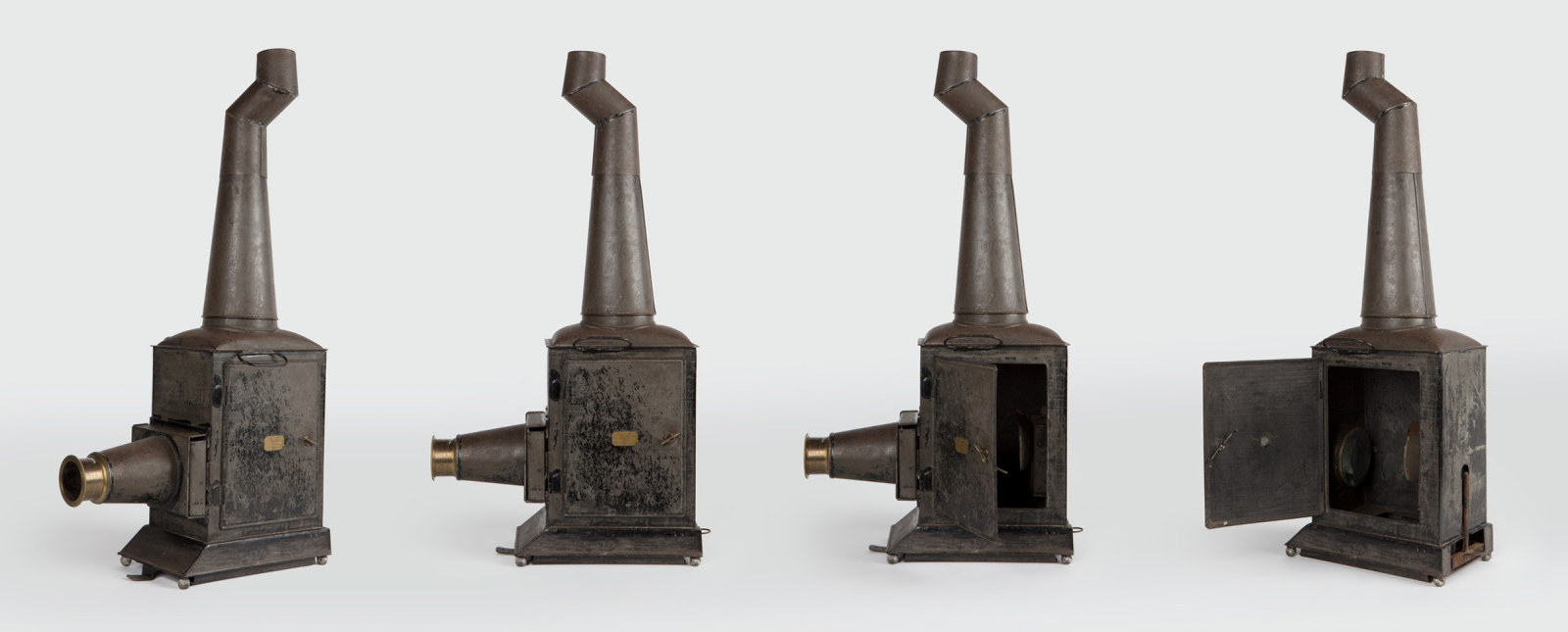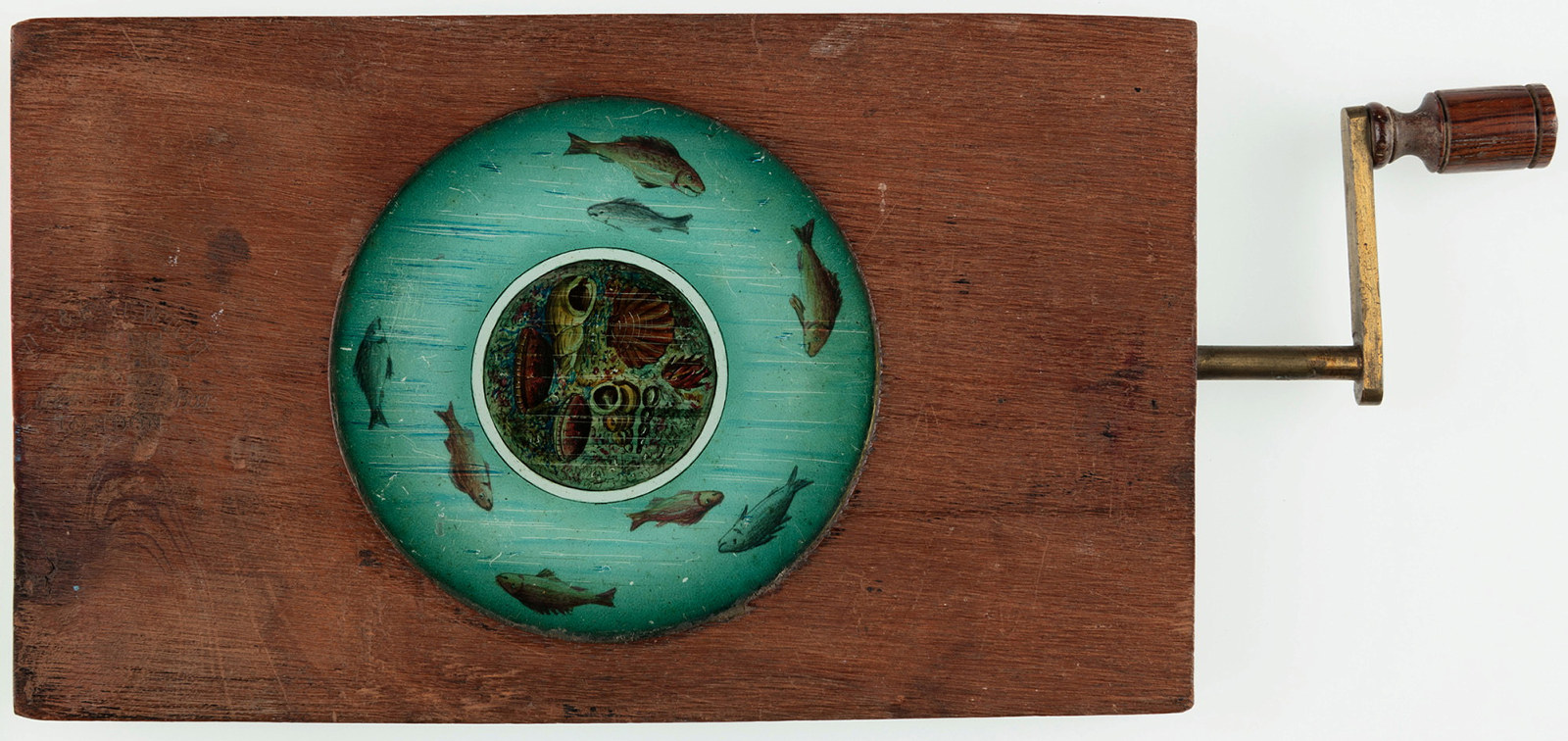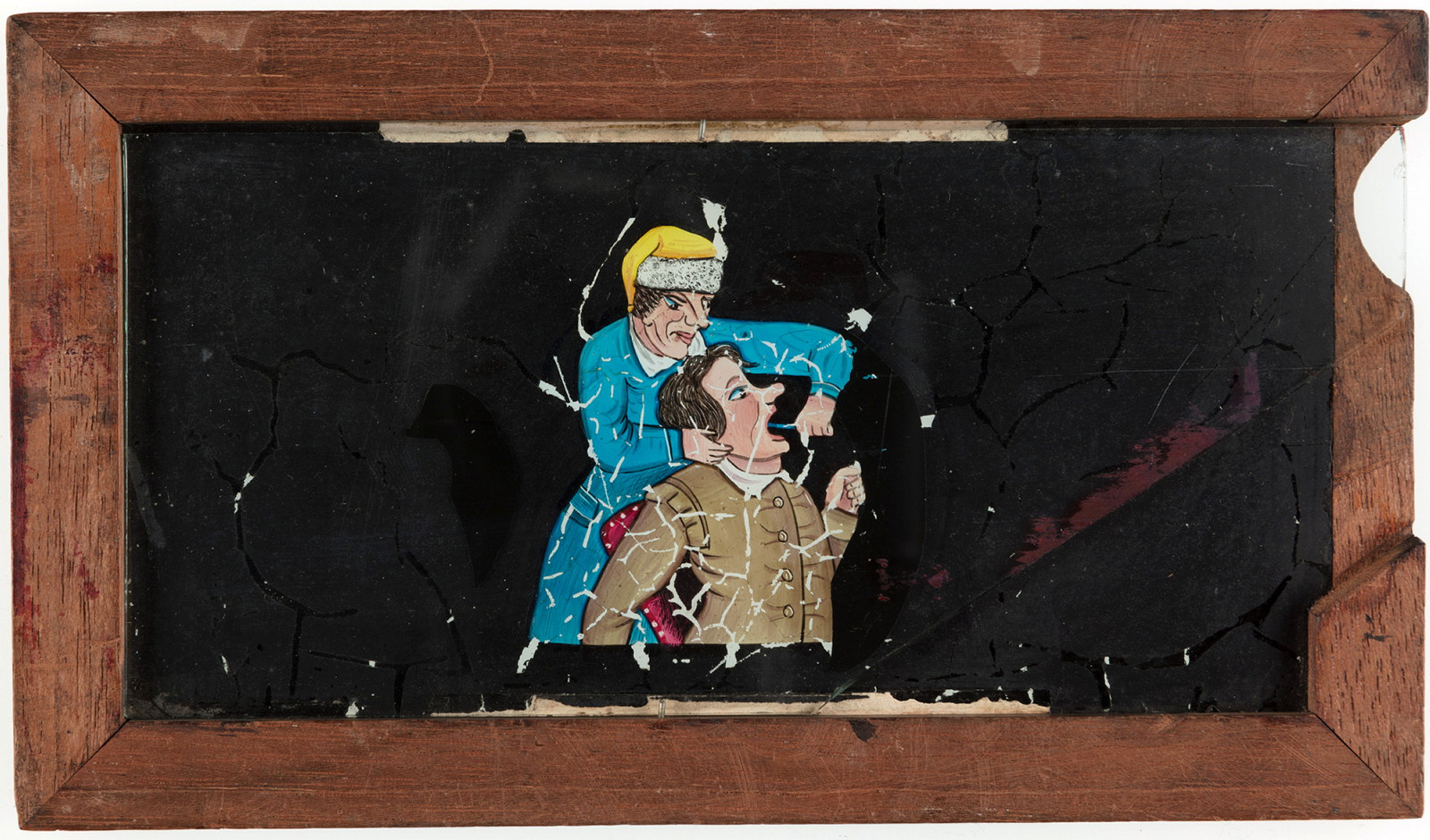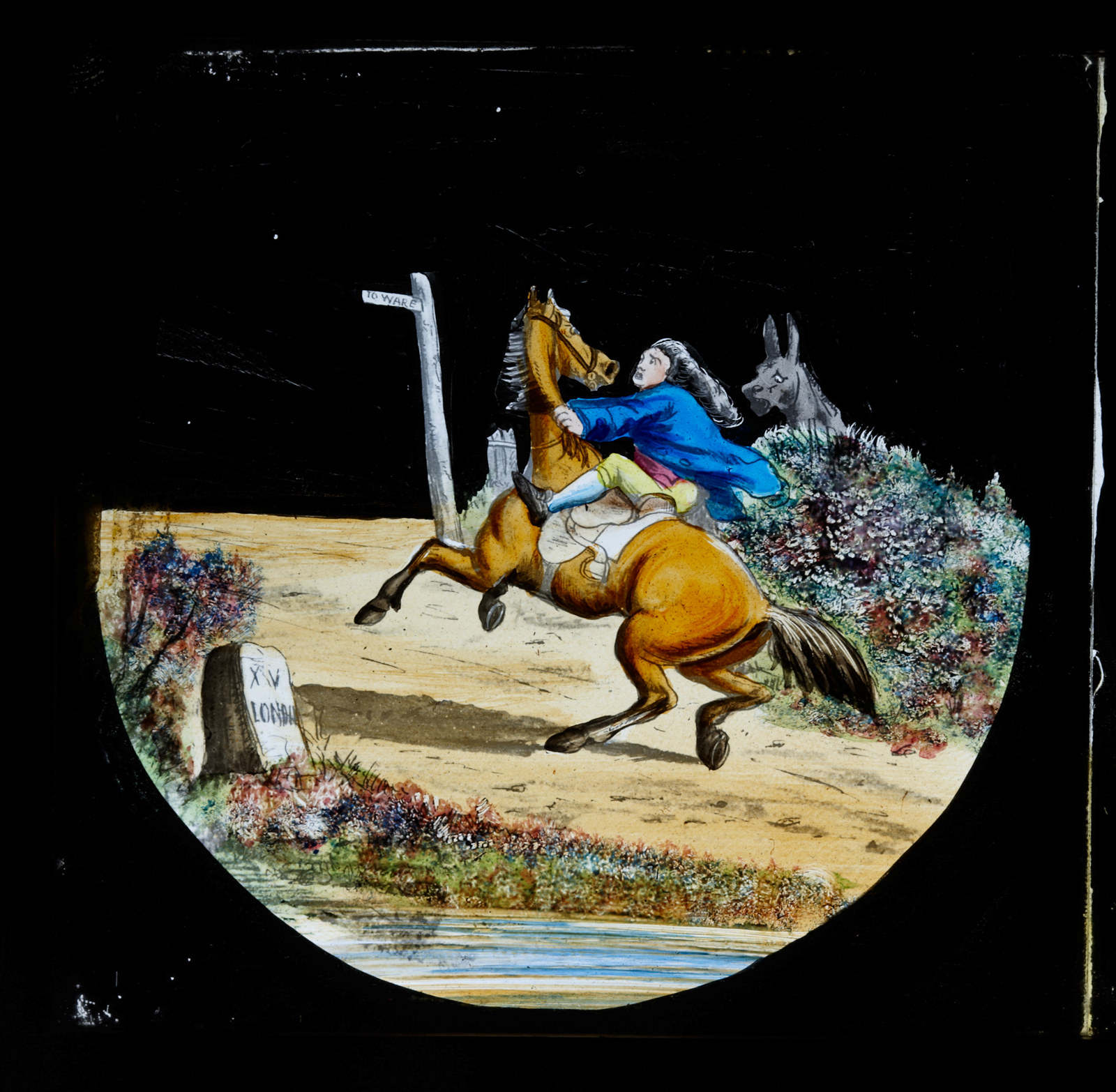Tale of Tiger and Tub
The Rouse Hill Estate's set of magic lantern slides titled on the slide mounts as ‘Tiger in the Tub’ is a comic story, told in eight scenes, of two Anglo-Indian residents of Bengal who decide to have a picnic in the countryside.
They instruct their servants to pack food and drink into a barrel, or tub, and take it to a suitable glade. The barrel is full of good things and the men indulge themselves, but the picnic is disturbed by the arrival of a Bengal tiger. The two men - one short and stout and one tall and thin - play dodge with the tiger around the tub until they manage to get the tub on top of the tiger and hold it down by standing on it. But the men are trapped too because they cannot leave without freeing the tiger. It's a stalemate until the tiger's tail emerges from a bunghole in the tub. They tie a knot in the tail and thus hobble the tiger.
The slide set was produced by Newton & Co, probably around 1860, and listed in their catalogues as ‘Tale of tiger and tub’ or simply as ‘The tale of a tub’. The story and the scenes are based closely on a book titled The new tale of a tub; an adventure in verse, by F.W.N. Bayley with seven lithographed illustrations. It was first published in London in January 1841 and provided the source not only for Newton & Co but also for other makers of lantern slides.
The new tale of a tub: an adventure in verse
The new tale of a tub: an adventure in verse by F.W.N. Bayley, with illustrations designed by Lieutenant J.S. Cotton, lithographed by Edward Aubry, was first published in January 1841 by London printsellers Colnaghi & Puckle. The ‘new’ in the title refers to an early 18th century publication by Anglo-Irish satirist, essayist, poet and cleric Jonathan Swift. Swift’s satirical tale was intended as a defence of the Anglican church, but widely interpreted by contemporary readers as an attack on all religion. The new tale of a tub is a rather more light-hearted parody of the foibles of human nature, set in India during the British Raj.
It was Colnaghi & Puckle’s first book, produced as a large-format quarto and promoted as “a pictorial comedy of illustration, lithographed to the life in seven narrative designs of adventure”. It was an instant publishing success, going into three editions in its first year of publication. The reviews were especially enthusiastic about Aubry’s finely engraved illustrations, declaring it be an “an excellent book to be laid on a drawing-room table, like a portfolio of caricatures, for the amusement of an evening party.”
In 1847 the tale was published in a reduced format, a cheaper edition, followed by an even cheaper American edition in 1854 and a new English edition published by George Routledge & Co in 1857, all retaining the original illustrations. The first modification of the original illustrations came in 1867 when Routledge published an abridged children’s version in their series of Shilling Toy Books, with new lithographs by Messrs Leighton Brothers.
For further details, see our library catalogue.
A company named Millikin and Lawley produced a seven slide set accompanied by a reading that used scene titles derived directly from the lithograph titles in Bayley‘s book: Opening the Question; Bengal Ease; The Artful Dodge; Look before you Leap, Under Cover, Increasing the Interest of the Tail; and a Knotty Point.
Sydney merchants Brush and Macdonnell advertised just such a seven slide set of ‘New Tale of a tub ’in May 1863. Newton’s extra slide - number two in the set, depicting the tiger rousing from slumber - enabled their set to be mounted in timber frames in two sequences each of four views and seems to have been created by Newton's own artists.
A tale of a tiger
The illustrations for the New tale of a tub were based on drawings by Lieutenant John Stedman Cotton of the Madras Light Infantry, a regiment of the British East India Company. He was born in 1812 at Tranquebar (now Tharangambadi), a town in the Nagapattinam district of the Indian state of Tamil Nadu on the Coromandel Coast. His father John Cotton was a Director of the East India Company and his mother Sophia Charlotte Stedman also came from an East India Company family. Cotton was thus well placed to tell a comic satirical story of two gentlemen employed in the company’s civil service. Cotton entered the company’s military service in January 1834 as a cadet. He was promoted from Senior Cornet to Lieutenant in the Madras Light Infantry in January 1837 and to Captain in March 1840. He died on 17 October 1843 at Chittoor in the southern Indian state of Andhra Pradesh.
Cotton was surprised by the publication of Bayley’s New tale of a tub which he saw for the first time in June 1841 when a copy reached him at Arcot in Tamil Nadu. Cotton’s own version of the tale, A tale of a tiger, with his original drawings, was published in 1842. His characters have a different back story and different comic names and his tiger is a tigress, but the main elements of the narrative are similar. The real, Lamarckian twist in the tail/tale in Cotton’s story comes sometime after the tiger is hobbled and the men escape. One of them hears that ‘about a year of two after, two cubs were killed in the vicinity, having each a most extraordinary entanglement at the root of the tail, about the size and form of an oyster barrel’. Cotton suggests that these cubs might provide the answer to the ‘long disputed question’ of ‘to what extent the effects of external objects on a mother can inform the physical conformation of her unborn offspring’. Cotton’s twist found visual expression in at least one set of magic lantern slides published later in the nineteenth century which included a final slide depicting several little tigers, each with a tub on its tail.
For further details, see our library catalogue.
Watch the animation
About the authors
Megan Martin
Former Head, Collections & Access
Megan is the former head of Collections & Access at Sydney Living Museums. She has a particular interest in the working of the historical imagination, in teasing out the meanings of objects in museums collections and in crafting the stories that can be recovered/discovered through a close reading of those items of material culture.
Holly Schulte
Former Curator Digital Assets
Holly explored the extraordinary potential of digital imaging technology alongside the enduring appeal of analogue photographic collections. She was responsible for a range of collection related tasks with a focus on photography, digitisation and digital asset management. Her research interests address photography, collections, image making and associated technology.

Magic lantern at Rouse Hill Estate
The Rouse Hill House magic lantern is a mid-19th century example of a form of image projector which dates back to the 17th century
Published on
Related
Browse all
Animated comic sliders for magic lantern
The magic lantern was a popular entertainment technology in the 19th century used to project stories and comic scenes.

Comic sliders
The Rouse Hill Estate collection of magic lantern slides includes ten comic slip slides, also called sliders or slippers

John Gilpin’s Ride
The fictional story of John Gilpin and his misadventures on a runaway horse was originally written as a comic ballad by English poet William Cowper in 1782

Magic lantern at Rouse Hill Estate
The Rouse Hill House magic lantern is a mid-19th century example of a form of image projector which dates back to the 17th century